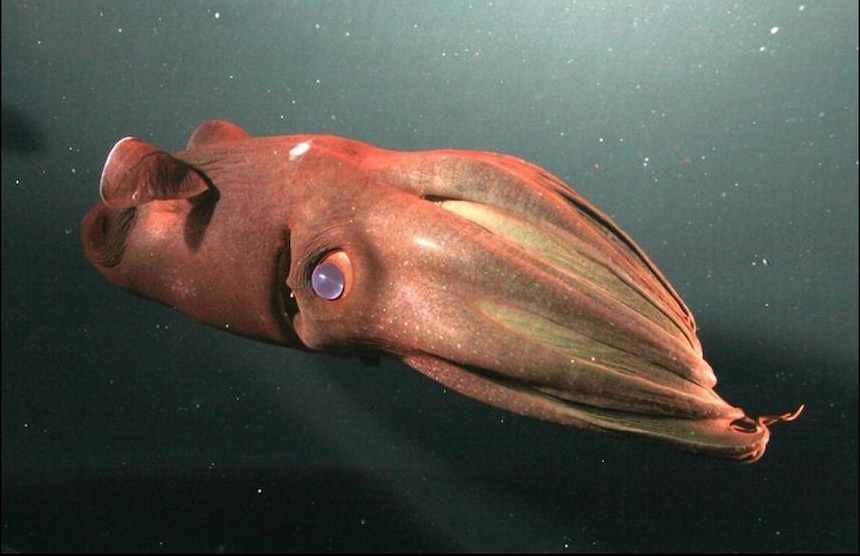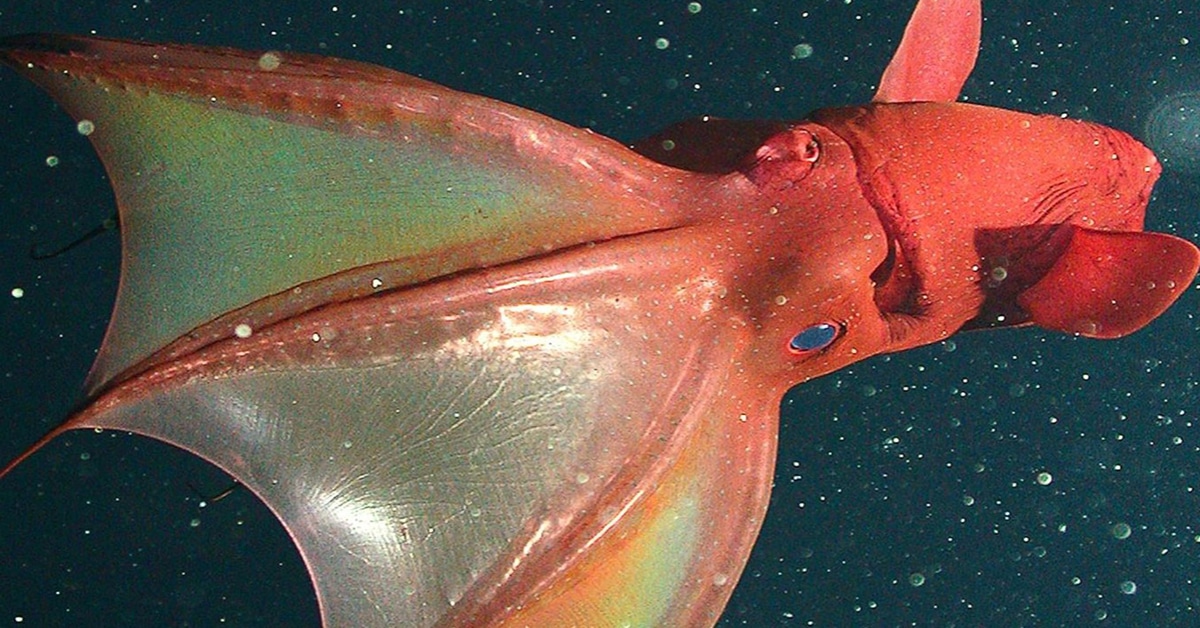Vampire Squid – All About Habitats & Characteristics
Have you heard about the vampire squid? It is incredibly challenging to research vampire squids in their natural habitat, as it is with most deep-sea species, so little is known about their behavior and characteristics. However, it’s clear they have some very unusual properties. That’s why scientists want to learn more about this unusual and fascinating animal as they continue to explore the deep ocean.
In this article, we will discuss the vampire squid, its traits, and some fun information you probably didn’t know about these mysterious and challenging creatures.

What is Vampire Squid?
Let’s first get to know vampire squid – the only known members of the Order Vampyromorphida. The name refers to the creatures, which are not squids and have reddish-brown skin, webbing between their arms, and blue eyes.
There’s a pretty big chance you’ve never met this intriguing creature since the vampire squid can only be found in tropical and temperate deep waters. The vampire squid, which was frequently misidentified as an octopus due to its lack of the two long tentacles that typically extend past a squid’s eight arms, actually possesses characteristics of both squids and octopi.
How Does Vampire Squid Look?
When you first look at a picture or video of the vampire squid, it’s impossible not to first notice its huge eyes – one of its most distinctive features. It possesses the largest eyes of any living creature when compared to its size!
A vampire squid’s eyes may flash vivid blue in a picture. However, they aren’t blue. The eyes of a vampire squid are transparent, but they reflect the surrounding water and take on a blue appearance. The creature gets its common name – the Vampire Squid – from its big, vivid blue eyes. It also has a dark hue and silky, cloak-like webbing that joins its arms.
Habitat of the Vampire Squid
What distinguishes the creature the most from all the other organisms on earth? The oxygen-minimum zone is home to the vampire squid. Although most species find it difficult to survive in the deep sea’s chilly, dark, low-oxygen conditions, the vampire squid has evolved special defenses that it employs to endure the harsh environment of the deep water.
A vampire squid needs to store its energy since the deep sea has little oxygen and unreliable nourishment. Since it has the slowest metabolism, food’s energy is used for a longer period. It doesn’t require much energy to stay suspended in the water column because it is naturally buoyant and its gelatinous body is only marginally denser than the seawater around it.
The vampire squid makes the most of the little oxygen available to it. Its large gill surface area allows it to absorb more oxygen. In its blood, the respiratory pigment that carries oxygen has the highest affinity for oxygen of any known cephalopod species.
Diet and Feeding Behavior
Copepods, prawns, and cnidarians have all been observed being consumed by carnivorous vampire squids. They have a very low mass-specific metabolic rate because they rely less on movement to evade predators and capture prey. It is the only species of cephalopod that is currently alive that does not eat live prey. The vampire squid can detect larger marine snow particles because of its keen vision.
Sensory filaments and light-producing organs are positioned at the tips of the arms to seek food and escape from predators in deep water. The squid moves in a circle to try to catch its prey after using one filament at a time to find it.
Marine snow gets its name because, when illuminated by a submarine’s headlights, it slowly drifts down to the deep sea and resembles an underwater snowstorm. Large, deep-diving fishes, pinnipeds (seals and sea lions), whales, and benthopelagic fishes have all been found to contain vampire squid beaks.
To feed, the mucus-coated, two fragile filaments of the vampire squid are stretched. The organism scrapes the trapped food off while pushing its filaments through its arms to collect the marine snow. The mucus dumpling is slowly transported under its mantle to its mouth, where it is eaten.
Defense Strategies
Even if a vampire squid lives that deep, it still needs strong defense mechanisms. The pigment sacs in cephalopods like octopuses and squids are controlled by specialized muscles that enable them to change color.
Because they lack these muscles, vampire squid cannot change color. Color-changing is a useless tactic for an organism that lives in the darkest depths of the ocean, where little light reaches it. An abundant cloud of sticky, bioluminescent mucus is instead squirted by the vampire squid in the direction of potential predators.
Because The vampire squid lacks ink sacs, like many deep-sea cephalopods. When threatened, it will curl its arms upward and around its body, turning inside-out and exposing its spiny projections.
The vampire squid hides in its web-like cloak to fight off predators while crossing its arms over its body. By doing so, it conceals its mantle and reveals the spiky-appearing fleshy appendages on the back of its webbed limbs. One of the vampire squid’s arms can regenerate if the top is broken or bit off; a tiny price to pay for a speedy getaway!
Mating and Life Cycle of Vampire Squid
Even while vampire squids aren’t truly immortal, they do seem to live long lives for cephalopods. A study, according to the Washington Post, reveals that deep-sea squids have a reproductive technique that has never been seen in an octopus or squid before.
Unlike their close relatives, vampire squids do not produce all of their eggs in a single high-energy burst. They go through multiple reproductive cycles. That implies they probably have slightly different lives for the entirety of their existence than cephalopods living in shallow oceans.
The majority of cephalopods do not reproduce more than once in their lifetime. However, vampire squids do. A male vampire squid uses its funnel to transmit sperm to the female. The female fertilizes her eggs with sperm before releasing the fertilized eggs into the water column. She spawns infrequently and with quite low energy expenditure.
The fertilized vampire squid egg grows into a larva with an enormous head and eight short arms. The vampire squid has four fins on its mantle as a juvenile. As the animal ages, two of these fins are reabsorbed into its body. Scientists were perplexed for a long time since they believed the adult vampire squid was a different species from the adolescent due to its peculiarity among all living cephalopods.
Scientists once believed that there were up to 10 separate species of vampire squid because they each have a distinctive appearance during different phases of growth.
Are There Any Vampire Squid Predators?
Because there is little oxygen in the area of the deep water where the vampire squid lives, there are few predators there as well. However, there are predators, such as fish, cephalopods, sea lions, sharks, and whales, so vampire squid isn’t that safe even in the deep oceans.
Climate change has an impact on deep-water creatures. As the waters warm, scientists have detected an increase in the frequency of “dead zones” with low oxygen levels. In addition, the vampire squid’s home, the deep oxygen-minimum layer, is expanding.
Researchers study the survival strategies of organisms that inhabit the oxygen-minimum layer, including the vampire squid. They contrast these species with those that don’t live in this region to get a better understanding of how the ocean is changing.
Final Words
Now, you have more information about these amazing and mysterious creatures deep in the ocean. However, even though we know that they exist, many people still think they are a myth since they can’t imagine how staying alive is possible in the minimum-oxygen zones. Well, the vampire squid is very real, and to sum up, here are some reasons why it can stay alive:
- The Vampire squid has large gills. The vampire squid has gills that cover a wide surface area. This enables a greater oxygen intake in an environment where there’s only a limited amount of oxygen to go around.
- It has low metabolic rates. Vampire squid doesn’t expend a lot of energy, and they aren’t quick to digest their food. They’ll also refrain from using certain defense mechanisms against predators unless it’s necessary. The defense mechanisms can take a lot out of them.
- The vampire squid has an Increased buoyancy. Their soft, gelatinous bodies aren’t much denser than the seawater around them, so vampire squid can float well. They also have ample amounts of statocysts. These are organs related to balance; they operate a bit like the fluid in a human ear. Statocysts keep the vampire squid coordinated.
This creature once more proves that nature has amazing powers, and there’s still more to discover. The vampire squid is not a dangerous undersea predator, despite its moniker. They are peaceful, eat plankton, and have some interesting characteristics that experts love to investigate.
Well, if you desire more information about these mysterious organisms, let’s wait and see what will be discovered in the future.

Nato is a content writer and researcher with a background in psychology who’s eager to explore the wonders of nature. As a travel enthusiast and animal lover, she hopes to inspire others to discover and cherish the beauty and importance of the natural world.

